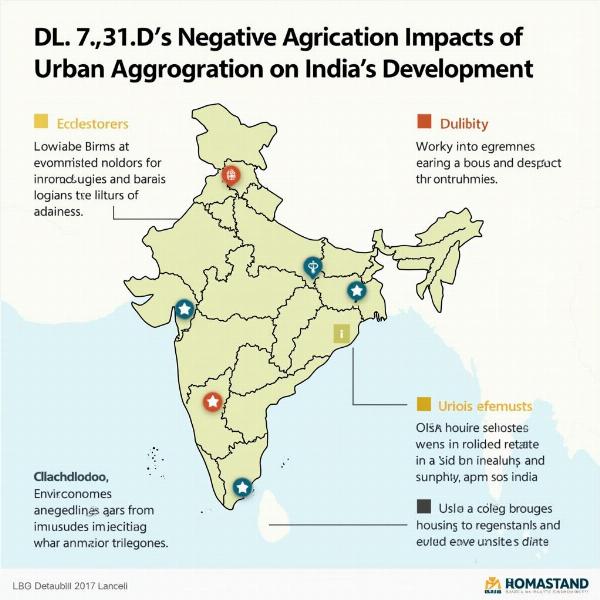Urban agglomeration, a term frequently encountered in discussions about India’s rapidly developing urban landscape, can be confusing. Understanding its meaning in Hindi, along with its implications, is crucial for grasping the dynamics of urban growth in India. This article delves into the “urban agglomeration meaning in Hindi,” exploring its various facets and providing a comprehensive understanding of this important concept.
What Does Urban Agglomeration Mean?
Urban agglomeration essentially refers to a continuously built-up urban area comprising a core city and its surrounding suburbs, towns, and outgrowths. These areas are characterized by close economic and social ties, often sharing resources and infrastructure. In Hindi, urban agglomeration is commonly referred to as “नगरीय समूह” (Nagariya Samooh). This term effectively captures the idea of a cluster or collection of urban areas functioning as a single unit. Think of it as a network of interconnected urban spaces, each contributing to the overall urban fabric.
Defining Urban Agglomeration in the Indian Context
In India, the Census of India defines an urban agglomeration based on specific criteria, including population size, density, and the proportion of the population engaged in non-agricultural activities. Understanding these criteria is essential for correctly interpreting urban growth statistics and planning urban development strategies. This nuanced definition helps distinguish urban agglomerations from smaller urban centers or isolated towns.
Why is Understanding Urban Agglomeration Important?
Understanding urban agglomeration is crucial for effective urban planning and resource allocation. By identifying these interconnected urban spaces, policymakers can better address challenges related to infrastructure development, transportation management, and environmental sustainability. It also allows for a more accurate assessment of population growth trends and the changing needs of urban dwellers.
Key Components of an Urban Agglomeration
Several key components characterize an urban agglomeration:
- Core City: The central, most densely populated urban area.
- Outgrowths: Areas surrounding the core city, often residential or industrial.
- Suburbs: Residential areas located on the outskirts of the core city.
- Interconnectedness: Strong economic and social ties between the core city and its surrounding areas.
Urban Agglomeration vs. Metropolitan Area: Is There a Difference?
While often used interchangeably, “urban agglomeration” and “metropolitan area” are distinct concepts. Metropolitan areas generally represent a larger urban area encompassing multiple urban agglomerations. The distinction lies in the level of integration and interconnectedness between the constituent urban centers.
How Does Urban Agglomeration Affect India’s Development?
Urban agglomerations play a significant role in India’s economic growth and development. They serve as hubs for industrial activity, innovation, and employment opportunities. Understanding their growth patterns and addressing their specific challenges is crucial for ensuring sustainable and inclusive urban development in India.
 Impact of Urban Agglomeration on India's Development
Impact of Urban Agglomeration on India's Development
Conclusion: Navigating India’s Urban Future
Understanding “urban agglomeration meaning in Hindi” – नगरीय समूह (Nagariya Samooh) – and its implications is essential for comprehending the complexities of urban growth in India. As India continues to urbanize, these interconnected urban spaces will play an increasingly important role in shaping the country’s future.
FAQ:
- What is the Hindi word for urban agglomeration? The common Hindi term for urban agglomeration is “नगरीय समूह” (Nagariya Samooh).
- How is urban agglomeration defined in India? The Census of India defines it based on population size, density, and non-agricultural activities.
- Why are urban agglomerations important? They are crucial for economic growth, job creation, and innovation.
- What are the challenges of urban agglomerations? Challenges include infrastructure development, managing transportation, and environmental sustainability.
- What is the difference between an urban agglomeration and a metropolitan area? Metropolitan areas are larger and encompass multiple urban agglomerations.
About Meaning-Hindi.in
Meaning-Hindi.in is your trusted partner for professional Hindi translation services, catering to diverse needs ranging from business and legal documents to technical manuals and website localization. We specialize in delivering accurate and culturally sensitive translations, ensuring your message resonates effectively with your target audience. Whether you need business document translation or specialized technical translation, our expert team provides high-quality services tailored to your specific requirements. Contact us today for all your Hindi translation needs! Email: [email protected], Phone: +91 11-4502-7584.